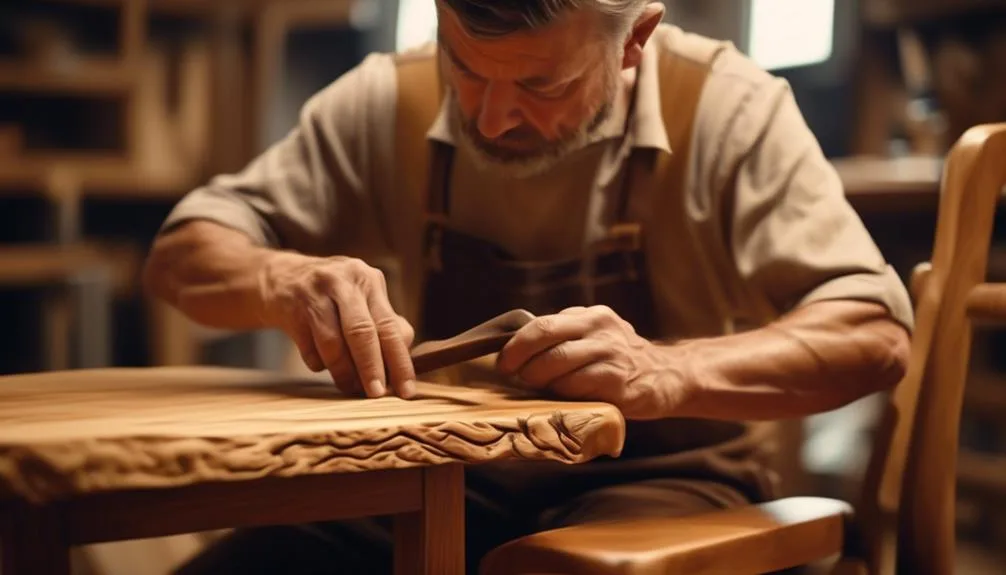Elm wood has a long history in furniture making, known for its durability and timeless appeal. But is it suitable for modern furniture?
Let's examine elm wood's strength, workability, and aesthetic qualities to determine its potential for crafting high-quality, long-lasting furniture.
Strength and Durability of Elm Wood
When you're considering elm wood for furniture making, its strength and durability make it a top choice for long-lasting, high-quality pieces.
Elm wood is known for its impressive strength, making it suitable for withstanding the wear and tear of everyday use.
Its durability ensures that furniture made from elm wood can stand the test of time, making it a practical investment.
In terms of maintenance and care, elm wood furniture requires minimal effort to keep it looking its best. Regular dusting and occasional polishing can help maintain its natural beauty. Additionally, ensuring proper humidity levels in the room can prevent the wood from drying out or cracking.
With its exceptional strength and longevity, elm wood is an excellent option for crafting sturdy and enduring furniture pieces.
Workability and Ease of Elm Wood
With its workability and ease of use, elm wood offers furniture makers a versatile and practical material for creating exquisite and functional pieces. Elm wood is known for its moderate to high workability, allowing for ease in cutting, shaping, and sanding. It responds well to various finishing techniques, such as staining, painting, and polishing, making it adaptable to different design preferences.
The wood's straight grain and medium texture also contribute to its workability, enabling craftsmen to achieve smooth and refined surfaces. When working with elm wood, you'll find that it cooperates well with both hand and machine tools, enhancing the overall woodworking experience.
Its workability and responsiveness to finishing techniques make elm wood an excellent choice for crafting high-quality furniture with intricate details and a polished appearance.
Aesthetic Qualities of Elm Wood
You've experienced how elm wood's workability and ease of use make it a versatile material for crafting furniture. Now, let's explore the aesthetic qualities that make elm wood a standout choice for creating visually stunning pieces. Elm wood is renowned for its natural beauty, boasting a rich, warm tone that adds a touch of elegance to any furniture piece. Additionally, elm wood exhibits a decorative grain pattern that varies from straight to interlocked, creating visual interest and texture. The unique and intricate patterns in the grain make each furniture piece one-of-a-kind, adding a sense of individuality and charm to your living space. Here's a glimpse of how elm wood's aesthetic qualities enhance the appeal of furniture:
| Natural Beauty | Decorative Grain Pattern | Visual Interest |
|---|---|---|
| Warm, elegant tone | Varied grain patterns | Unique and charming |
Suitability for Different Furniture Types
Elm wood's versatility extends to its suitability for various furniture types, making it an excellent choice for crafting a wide range of pieces.
When considering Elm wood for outdoor furniture, its natural resistance to decay and durability make it an ideal option for outdoor benches, chairs, and tables. Its ability to withstand varying weather conditions ensures longevity.
For kitchen furniture, Elm wood's tight grain and smooth finish make it perfect for crafting cabinets, countertops, and dining tables. Its natural resistance to moisture and strength make it suitable for withstanding the demands of a busy kitchen.
Whether for outdoor use or kitchen settings, Elm wood's versatility and durability make it a great choice for crafting furniture that can withstand the test of time.
Considerations for Elm Wood Furniture Making
Consider important factors such as grain patterns, moisture content, and the intended furniture use when selecting Elm wood for furniture making. Elm wood characteristics, such as its interlocking grain, make it resistant to warping and splitting, making it suitable for furniture construction. Additionally, its moderate moisture content allows for ease of drying and shaping. When considering the intended furniture use, Elm wood is versatile and commonly used for crafting chairs, tables, and cabinets. The following table outlines popular Elm wood furniture trends:
| Furniture Type | Characteristics | Trends |
|---|---|---|
| Chairs | Sturdy, durable, and elegant | Modern and minimalist designs |
| Tables | Resistant to warping and splitting | Rustic and farmhouse styles |
| Cabinets | Easy to carve and finish | Scandinavian and mid-century modern |
Understanding these considerations will help you make informed decisions when using Elm wood for furniture making.
Conclusion
In summary, elm wood's strength, durability, and versatility make it a compelling choice for crafting a range of furniture.
While its workability presents challenges, the resulting pieces can be both beautiful and enduring.
When considering elm wood for furniture making, weighing its qualities against project requirements is crucial.
Ultimately, the enduring allure of elm wood offers the potential to create lasting and timeless furniture pieces.

My interest in trees started when I first saw the giant sequoias in Yosemite.
I was a teenager then, and I remember thinking, “I need to learn more about this.”
That moment stuck with me.
A few years later, I went on to study forestry at Michigan Tech.
Since graduating, I’ve worked in a mix of hands-on tree care and community education.
I’ve spent over ten years helping people understand how to plant, maintain, and protect the trees in their neighborhoods.
I don’t see trees as just part of the landscape.
They are living things that make a real difference in our daily lives.
